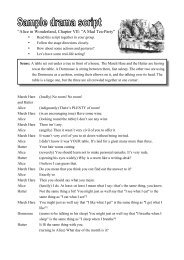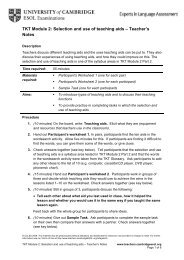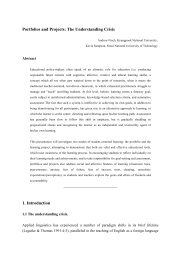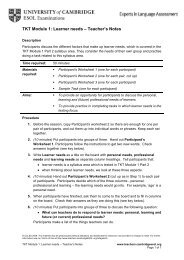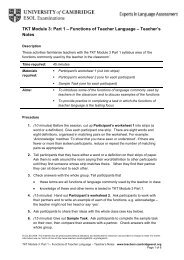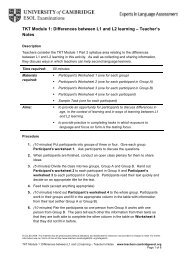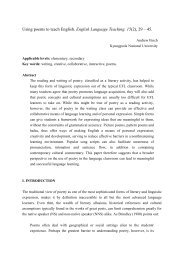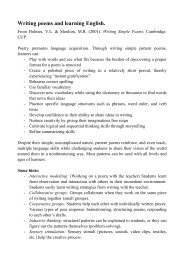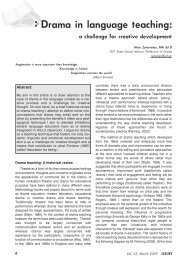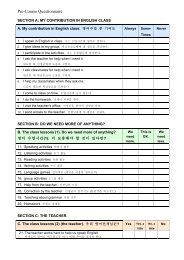here - Finchpark
here - Finchpark
here - Finchpark
Create successful ePaper yourself
Turn your PDF publications into a flip-book with our unique Google optimized e-Paper software.
Chinese-speaking community. Lao’s study found a gap between the proficiency levels expected byparents and the actual performances of their children. It also found that the parents felt that theirlimited use of Chinese and the lack of other family resources were contributing factors to this gap.On the other hand, two case studies with Japanese parents (Shibata, 2000; Siegel, 2004) suggestedthat these parents saw an important role for Japanese schools in their children's Japanese languageeducation. Shibata's (2000) case study of one Japanese immigrant family examined how the family'sefforts at raising bilingual children were assisted by a community-based Saturday Japanese school,located in a small city with "low ethnolinguistic vitality.” In Siegel's (2004) study, two Japaneseimmigrant mothers, whose children attend a newly established JHL school in Arizona, wereinterviewed. The data describe parental views of their children's experiences in the after-schoolprogram (every Friday, 40-50 minutes).Shibata (2000) and Siegel (2004) suggested that Japanese parents support Japanese languagemaintenance and believe that Japanese schools play an important role in Japanese language andcultural maintenance, and serve as a place for socialisation with other JHL learners.Tse (1998b) reviews available studies comparing ethnic minority students who haveexposure to HL programs and others who do not. She concludes that HL programs have apositive impact on language attitudes in most studies, suggesting beneficial outcomes fromexposure to and/or instruction in the language. The subjects reported greater appreciation ofthe HL, confidence in using it, enjoyment in doing schoolwork in the language, and a desire tocontinue learning it. In addition, exposure to HL programs promotes a positive association andcloser identification with one's own ethnic group. In addition, all of the successful HLspeakers in Tse's (2001) study had enjoyed the institutional support provided by schoolapproval of the HL, either in the community or through their mainstream schools. The positiveexperiences primarily centreed around experiences w<strong>here</strong> teachers and/ or classmates valuedthe language ability the participants brought with them from home.Tse (2001) found that each participant saw their HL as being highly vital (useful and evenprestigious) and had (1) a peer group that used the HL; (2) contact with institutions that valuedthe language; and (3) parents who spoke the HL and encouraged its development. Amongthese, having a peer group who values the HL was the most critical. At some point in theirlives, each participant became part of a peer group who valued the HL. Possessing HL abilitywas critical for gaining access to, getting full membership in and/ or achieving a prominentposition within the particular social group. A second base of support that boosted theparticipants' opinions of the HL came from formal institutions that valued HL proficiency. Inall of the cases, learning the HL began with exposure to language and literacy experiences inthe home and community at an early age. For all of the participants, this linguistic foundationwas available through adolescence and early adulthood, when proficiency in the languagebecame more important for school, career, and/ or identity development.T<strong>here</strong> are currently over one thousand Korean HL schools in the United States, most ofwhich are organized and operated by Korean Christian churches. Many of these programs aresmall and offer a limited selection of courses. One of the major concerns of these programs isa lack of texts that are written specifically for heritage learners of Korean. Much of theinstructional materials that are currently used in Korean HL schools in America have been'donated from Korean embassies and have been formatted for Korean learning styles andlifestyles that are foreign to Korean American children' (Lee, 2002). T<strong>here</strong> is also a generalshortage of age-appropriate texts for older beginners (i.e. secondary school students andadults), who are put off by the childish content in many beginning Korean texts. Bookswritten for second-generation Korean Americans about Korean culture and history and theKorean immigrant experience are also very much in need (but see National Association for



